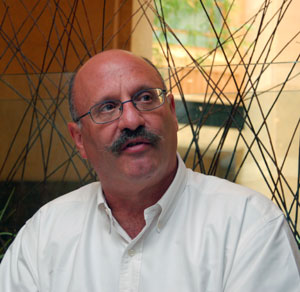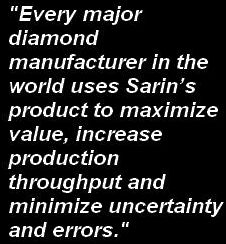 Daniel Glinert, chairman, Sarin Technologies.Photo by Sim KihTHE CHAIRMAN of Israel-based Sarin Technologies, Daniel Glinert, visits India sometimes for both business and a holiday, which was the case when we spoke with him in Chennai by phone recently.
Daniel Glinert, chairman, Sarin Technologies.Photo by Sim KihTHE CHAIRMAN of Israel-based Sarin Technologies, Daniel Glinert, visits India sometimes for both business and a holiday, which was the case when we spoke with him in Chennai by phone recently.His company, which has been listed on the Singapore Exchange since April 2005, is a worldwide leader in the development and manufacturing of advanced planning, evaluation and measurement systems for diamond and gemstone production.
According to Sarin’s website (www.sarin.com), “every major diamond manufacturer in the world uses Sarin’s product to maximize value, increase production throughput and minimize uncertainty and errors.”
Its gross profit margin has been very attractive. In FY07, it was 66%. Even in FY08, when Q4 was a nasty one, the full-year gross margin was 64%.
India accounted for 70% of Sarin’s revenue in FY08, not surprising considering that the country manufactures roughly 80% of the world’s diamonds.
Asked to describe the sentiment in India’s diamond manufacturing industry, Mr Glinert told us: “This is a very challenging period. From October, manufacturing stopped for the regular Diwali break and it was simply extended until mid-December.
" At the end of last year, sales in the US, in particular, dropped and the surplus inventory worked itself out of the pipeline – it hasn’t done so completely as yet – but manufacturing activity has become more robust from sometime in January. The average manufacturer is working at around two-thirds capacity.”
In Q4 of last year, Sarin suffered a loss of US$4.91 million versus a net profit of US$1.51 million previously. Revenue was US$2.6 million, down 71% from US$9.1 million in Q4 of FY07.
In our phone interview with Mr Glinert, we sought to understand Sarin’s business better, particularly the new Galatea technology which Sarin is confident would make a major difference to its customers.
Mr Glinert also explained the workings of IDEX Online, which Sarin acquired 23 % of in FY08, an Internet B2B spot market trading platform for rough diamonds.

A By far, most of our customers are manufacturers; others are in wholesale. Pure retail customers are in the minority – an exposure through retail chains in Hong Kong, the US and Singapore.
Q How do manufacturers make capex decisions? Do they look at the inventory or what?
A I don’t feel qualified to answer for them, but this is a challenging time which is why we are contemplating offering our new technology on a per-use basis so that capex is non-existent for our customers.
Q You are referring to the new product called Galatea?
A Yes
Q What about the other products?
A Right now, I would not expect to see a lot of capital expenditure in that department. Most of our customers have built up a capacity for planning that meets their needs in the current environment. As the new Galatea technology is rolled out, our customers need to upgrade their current systems to avail themselves of that revolutionary technology. As for our Quazer, green laser technology has an attrition rate.
Q Is there competition for these two products?
A For our Galatea, there is competition but it’s not on the same par. The Galatea technology offers for the first time the ability to really look into the internals of a rough diamond and detect and map the imperfections (or 'inclusions' in our jargon). The previous solutions were based on manual optical methods. The process entails shaving off part of the surface or polishing off parts, known as ‘opening windows’, then you can manually inspect the diamond with instruments such as a microscope.
The more advanced technology such as ours and some of our competitors use computer-aided technology that allow you to indicate, as you inspect, to the computer where you are seeing ‘inclusions’ and their sizes.
The drawback of the old technology is you need diamond experts to handle it and the process is time consuming and there is a probability of human error. A typical rough diamond can take hours and sometimes days to be scanned.
Our Galatea technology is unique in that it can do all those things automatically and comprehensively, and a full scan can be done in 15-20 minutes. And there is no need to do any pre-processing – ie, there’s no need to ‘open windows’. If a diamond doesn’t meet one’s requirements, it can be put back into the secondary market. But that cannot be done if it has ‘opened windows’.
Q Is this technology available only from 2009?
A It’s not fully available yet. It’s still in the beta-testing and beta service process. We will formally launch it from Q2. We will launch it initially in India and Israel and later in other diamond centers such as Belgium, South Africa, and Russia.

Q What is an estimate of its market size?
A We have estimates but it’s much too early to talk about that. We have to see how the market adopts it and this is a new business model where customers pay for on a per use basis. Since there is no competing technology on par, we believe the potential is very significant.
Q So customers have to go to Sarin to get the diamonds scanned by Galatea?
A That is our intent initially, but we expect over time the larger manufacturers to want the system operated by our personnel at their facilities. Currently, we don’t have any intent to sell the system as it is IT-intensive and complicated.
Q What cost savings would the users enjoy?
A The cost savings would be realized from the time saved – when you buy rough diamonds you have tied up working capital or credit lines. If you can turn them into polished diamonds and into the market quicker, you can resolve issues of working capital or credit. Another cost savings is in the cost of highly trained diamond experts. Thirdly, the polished diamonds will have higher clarity grades and be sold at higher prices.
Q What’s the feedback from your customers in terms of their interest in adopting this new technology?
A The feedback has been positive – we have no negative feedback. The industry and our customers are evaluating to what degree the technology can enable them to do better in their business. Nobody has been able to fully assess the full benefits of the system because the system has been in the beta testing for a few weeks so far.
Q Can you clarify one point: Will your customers have to take their diamonds to Sarin in order to use the Galatea? Where are the locations of the Sarin centers?
A We will open service centers in our offices in India and Israel to begin with. Starting from the second quarter, we will roll out the system in other parts of the world.
Q What will the machines cost if a manufacturer were to buy them?
A We haven’t discussed that yet because that’s not a relevant solution now.
Q Regarding the AGM, will that continue to be held in Israel?
A This year, it will be held in Israel to, among other reasons, save costs. We are in an intense challenging period and have cut costs – we have cut staff, and other measures. But I’d like to point out that we have facilities set up in Singapore where our shareholders can directly converse and attend the AGM. Unfortunately, due to legal issues, they cannot vote.
Mark Lee, Kamal Samuel and Sim Kih contributed to this article. The teleconference was arranged by Aries Consulting in Hong Kong (www.ariesconsulting.com.hk)
Part 2 on Tuesday (Mar 17) will feature questions and answers on Sarin’s best-selling products and the potential of its new acquisition, IDEX.







